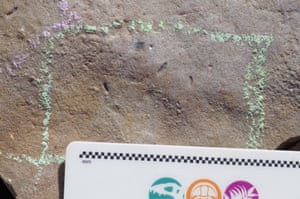Ikaria wariootia is half the size of a grain of rice and an early example of a bilateral organism
Source: The Guardian
It might not show much of a family resemblance but fossil hunters say a newly discovered creature, that looks like a teardrop-shaped jellybean and is about half the size of a grain of rice, is an early relative of humans and a vast array of other animals.
The team discovered the fossils in rocks in the outback of South Australia that are thought to be at least 555m years old.
The researchers say the diminutive creatures are one of the earliest examples of a bilateral organism – animals with features including a front and a back, a plane of symmetry that results in a left and a right side, and often a gut that opens at each end. Humans, pigs, spiders and butterflies are all bilaterians, but creatures such as jellyfish are not.
Dr Scott Evans, of the Smithsonian National Museum of Natural History and a co-author of the research, said: “The major finding of the paper is that this is possibly the oldest bilaterian yet recognised in the fossil record. Because humans are bilaterians, we can say that this was a very early relative and possibly one of the first on the diverse bilaterian tree of life.”
Writing in the Proceedings of the National Academy of Sciences, Scott and colleagues in the US and Australia report how they made their discovery in sandstone at sites including fossil-rich Nilpena. They say careful analysis ruled out the possibility that the fossils were actually formed by the action of currents or from microbial mats.
The animal has been named Ikaria wariootia in reference to an Indigenous term for Wilpena Pound, a nearby landmark, and the Warioota Creek that is close to the sites of the find.
The team not only found burrows, but more than 100 fossils of the tiny creatures themselves – essentially impressions of the animal in the rock – an unusual discovery since Ikaria wariootia, like many other animals of the time, were soft-bodied.
That, the researchers say, is important: bilateral organisms are thought to have evolved during the Ediacaran period that stretched from 571m to 539m years ago, however previous evidence for such creatures has largely relied on traces such as the burrows they made.
While the creatures were tiny – between 2mm and 7mm in length – their form reveals vital clues.
“One major difference with a grain of rice is that Ikaria had a large and small end,” said Evans. “This may seem trivial but that means it had a distinct front and back end, which is the kind of organisation that leads to the variety of things with heads and tails that are around today.”

The team say analysis of the burrows suggests Ikaria wariootia would have moved through the sediment of its shallow marine environment rather like an earthworm, by contracting groups of muscles. Furthermore, it would most probably have had a mouth and anus connected by a gut and fed on dead animals and other organic matter – conclusions drawn from the current finds together with evidence from similar burrows discovered several years previously within the fossils of other animals.
“We also can see from the burrows that it targeted food and oxygen, which tells us that it had the ability to sense things in its environment,” said Evans, adding that this offered new insights into our oldest bilaterian ancestors.
Prof Simon Conway Morris from the University of Cambridge, who was not involved in the work, described the findings as exciting. He said: “Although the tiny fossils are near the limits of resolution they both tantalisingly suggest a creature very close to the earliest known ancestor of all advanced animals and, even more intriguingly, a likely association with small traces made as the animal forged through the sediment in search of food.”
Source: The Guardian

































Leave a Comment
You must be logged in to post a comment.